This was published 4 years ago
D-Day 75th anniversary: Best sites to visit in England and France to experience the history of D-Day
By Mark Chipperfield
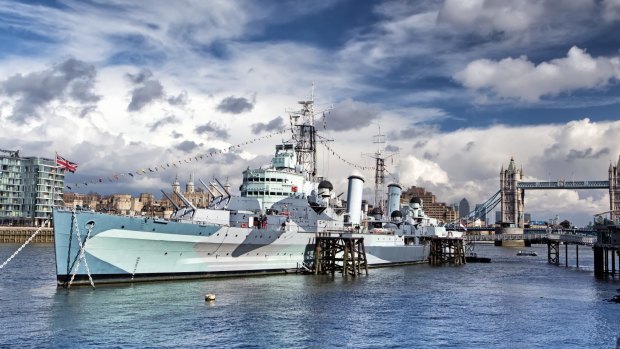
HMS Belfast warship is the British Royal Navy's last surviving cruiser and the largest preserved in Europe.Credit: Shutterstock
This year marks the 75th anniversary of D-Day, the largest amphibious military operation in history and the turning point in the war against Nazi Germany.
Following a ferocious aerial and naval bombardment of Hitler's notorious Atlantic Wall, 24,000 British, Canadian and American troops stormed the coast of Normandy in northern France. Initial losses were high – 2000 American troops were killed or injured at Omaha beach on the first day – but Allied forces eventually overcame the German defences and the hard-fought Battle of Normandy began in earnest.
The heroic struggle that took place on these beaches burns bright in the collective memory here, and the hinterland is still scarred by German gun emplacements, bunkers and other fortifications.
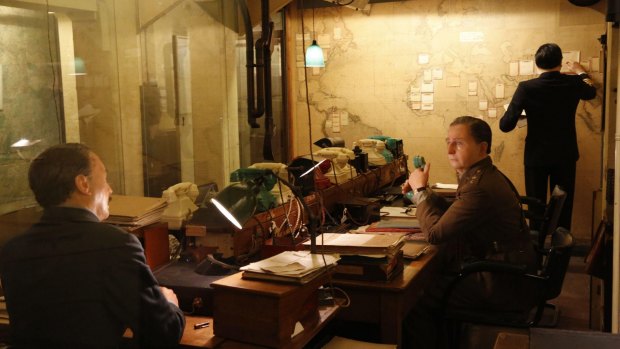
Inside the command centre of Winston Churchill during the Second World War: Churchill War Rooms, London.Credit: Alamy
Although the number of veterans, many in their 90s, is dwindling, interest in the Battle of Normandy only seems to intensify with each passing year. Those with a passion for military history, or a family connection with the events of June 6, 1944, will find a number of permanent D-Day exhibitions on both sides of the English Channel.
In Britain the Imperial War Museum has three special, ongoing exhibitions. There is also Portsmouth Museums' The D-Day Story, an interactive display located in the south coast city of Portsmouth.
Across the channel, a new British Normandy Memorial, by sculptor David Williams-Ellis, has recently been unveiled at Ver-sur-Mer. The memorial stands on a hill overlooking Gold Beach where 1000 Allied soldiers fell. If you wan to learn more about D-Day, here are the best sites to visit.
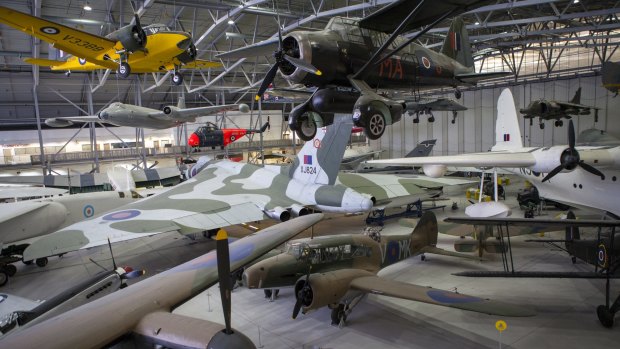
Some of the aircrafts on display at the Imperial War Museum Duxford in Cambridgeshire.Credit: Shutterstock
HMS BELFAST
A familiar sight on the River Thames at her moorings near Tower Bridge, HMS Belfast played a significant role in the Normandy landings, supporting troops going ashore at Gold and Juno beaches and knocking out a major German gun battery at La Marefontaine; the vibrations from her guns were so strong they cracked the crew's toilets. The light cruiser, part of the Imperial War Museum, also rescued Allied troops injured by enemy fire and visitors can see the sick bay where they were treated. All nine decks are open to the public. Of particular interest are the ship's logs from 1944 and recorded interviews with surviving crew members. Open daily 10am to 6pm. See iwm.org.uk
IMPERIAL WAR MUSEUM, DUXFORD
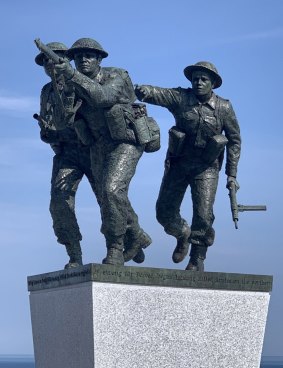
British Normandy Memorial sculpture by David Williams-Ellis, at Ver-sur-Mer, France.Credit: British Normandy Memorial
Many of the aircraft that flew on D-Day left from this historic RAF base, just south of Cambridge. Administered by the Imperial War Museum, this extensive site is Britain's largest aviation museum, with some 200 historic aircraft, military vehicles and naval craft. Alongside Spitfires, Lancaster bombers and Tiger Moths are aircraft of a more recent vintage, such as Vulcan bombers and American B-52s, plus a Concorde supersonic jet. The centre includes a separate American Air Museum and hosts popular air shows throughout the year. Visitors can explore several buildings, including the Watch Office, which dates from the 1930s. Open daily 10am to 6pm. See iwm.org.uk
CHURCHILL WAR ROOMS
Fascinating but also a little claustrophobic, the Cabinet War Rooms in London's Westminster were the setting for intense preparations prior to Operation Overlord and the invasion of occupied Europe. Apart from the various cabinet rooms and offices, the top-secret underground labyrinth also provided living quarters for Winston Churchill safe from Nazi bombs. Secrecy was maintained by the use of special noiseless typewriters – even whistling in the corridors was banned. Of particular interest is the prime minister's secure telephone line to Washington and the Map Room, which has been left just as it was on the final day of the war. The site also includes an interactive museum that tells the story of Churchill's remarkable life and long political career, plus some rare personal artefacts. Open daily 9.30am to 6pm. See iwm.org.uk
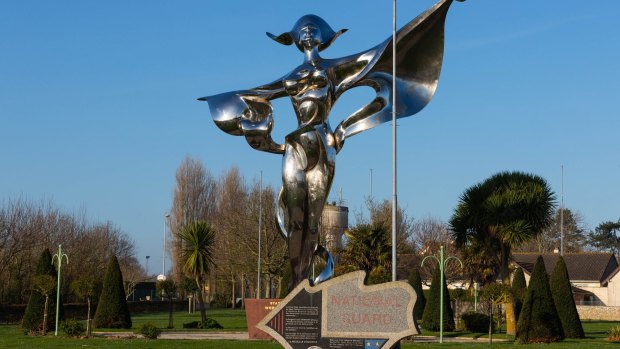
A US National Guard memorial and the World Peace Statue stand at the entry to Grandcamp-Maisy.Credit: Shutterstock
THE D-DAY STORY
As its name suggests this museum in Portsmouth is entirely devoted to the events of D-Day and the Battle of Normandy. Reopened in 2018 after a major facelift, the museum contains more than 10,000 historic items such as vehicles, uniforms, medals, maps and other documents – plus audio recordings of veterans. The collection covers the preparations for Operation Overlord, the Normandy landings and the legacy of the conflict. Highlights include a World War II LCVP landing craft, the Normandy Memorial Wall and the Overlord Embroidery. Australian visitors can use a special country-specific online guide to search for loved ones who were involved in the events of June 1944. Open daily from 10am to 5.30pm. See theddaystory.com
MUSEE DU MUR DE L'ATLANTIQUE
The Atlantic Wall, one of Hitler's most ambitious projects, was supposed to be impregnable. This imposing blockhouse, located in the French town of Ouistreham, provides some idea of the immense scale of the original defensive line. Le Grand Bunker is an authentic recreation of a typical German fortification. The five floors include a radio room, ammunitions store, medical bay, generator room and observation post. The interiors faithfully replicate conditions inside the blockhouse on the eve of D-Day. The museum also contains a treasure trove of photographs and documents about the Atlantic Wall. Open daily 9am to 7pm (April-September). See museegrandbunker.com
NORMANDY AMERICAN CEMETERY
Covering 70 hectares, this immaculate military cemetery is a sombre reminder of the cost of war. The site, located on the Normandy coast at Colleville-sur-Mer, overlooks Omaha beach, the scene of some of the most intense fighting on D-Day. The 9388 white crosses all point back across the Atlantic to the United States. Among those buried here is Theodore Roosevelt jnr, son of the American president. The site contains a central memorial, reflective pools, a small chapel, a wall of remembrance and an impressive visitor centre. The cemetery pays tribute to the dead of all nations. Open daily 9am to 6pm (April-September). See abmc.gov/cemeteries-memorials
MUSEE DU DEBARQUEMENT UTAH BEACH
The most ambitious of all the D-Day museums in France, this soaring structure stands on the very beach where American troops landed on June 6, 1944. Inside this stunning glass and steel building, the visitor will find a vast collection of war materials, artefacts and World War II vehicles. The centrepiece of the museum is an original B26 Marauder bomber. A separate gallery houses German weapons, military equipment and everyday objects used by Nazi soldiers. A number of smaller monuments are located near the museum, including one to the American 4th Infantry Division and another to Andrew Jackson Higgins, who developed the LCVP landing craft used by American troops on D-Day. Open daily 9.30am to 7pm (June-September). See utah-beach.com
MAISY BATTERY
Buried for more than 60 years, this complex of German trenches and bunkers is one of the best-preserved and original D-Day sites in Normandy. The battery, located near the village of Grandcamp-Maisy in Normandy, contains a number of fortifications, command posts, barracks and more than two kilometres of trenches. Visitors can stand exactly where the German defenders once stood and see exactly what they saw. Apart from the fortifications themselves, Batterie de Maisy also offers an extensive (and growing) collection of World War II material, such as cannons, howitzers and landing craft. Strategically located near Omaha and Utah beaches, this military complex was the scene of intense fighting between German and American forces. It was finally taken on June 9, 1944, after a five-hour assault by US Rangers. Open daily 10am to 7pm (high season). See maisybattery.com
Sign up for the Traveller Deals newsletter
Get exclusive travel deals delivered straight to your inbox. Sign up now.